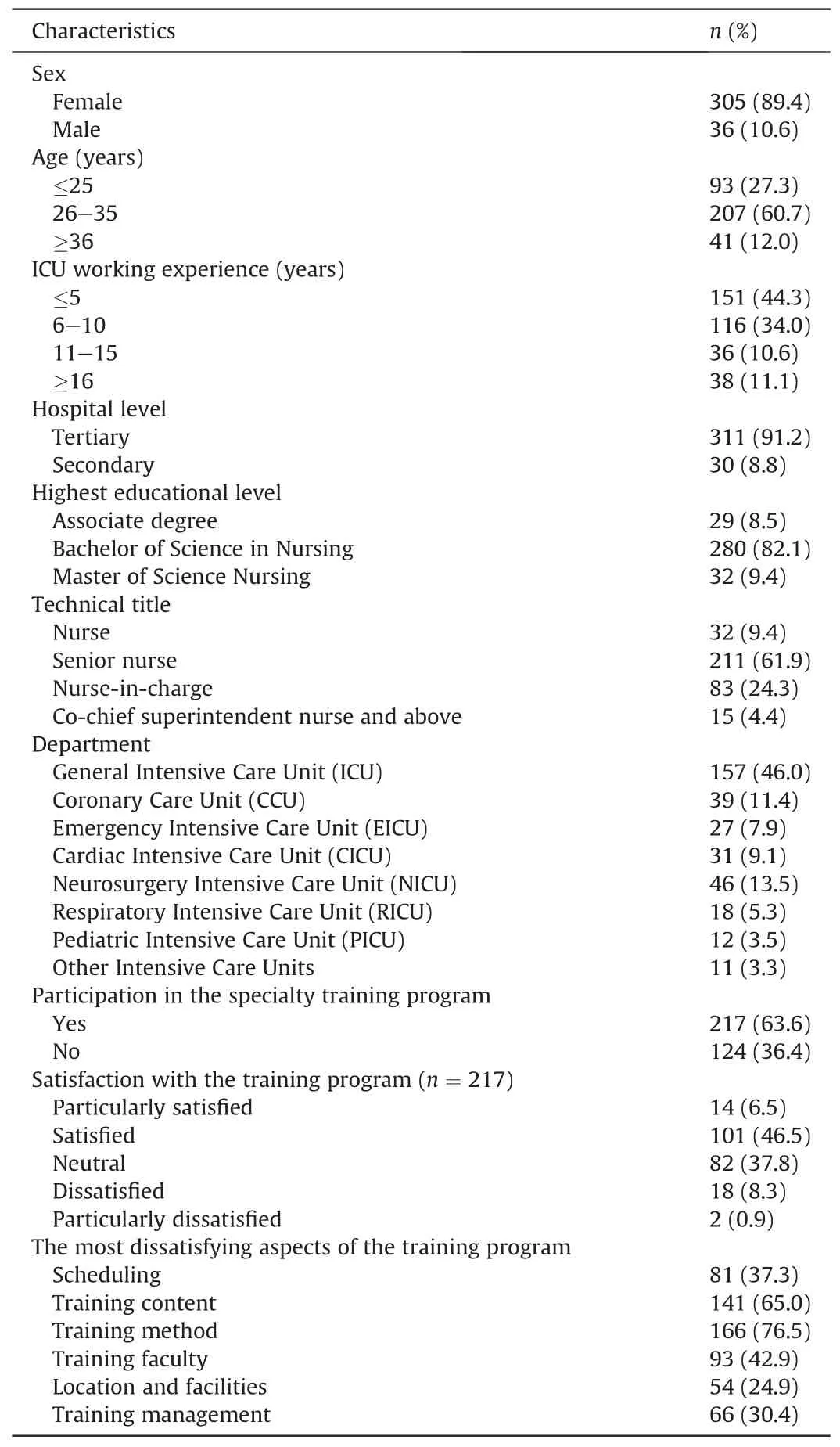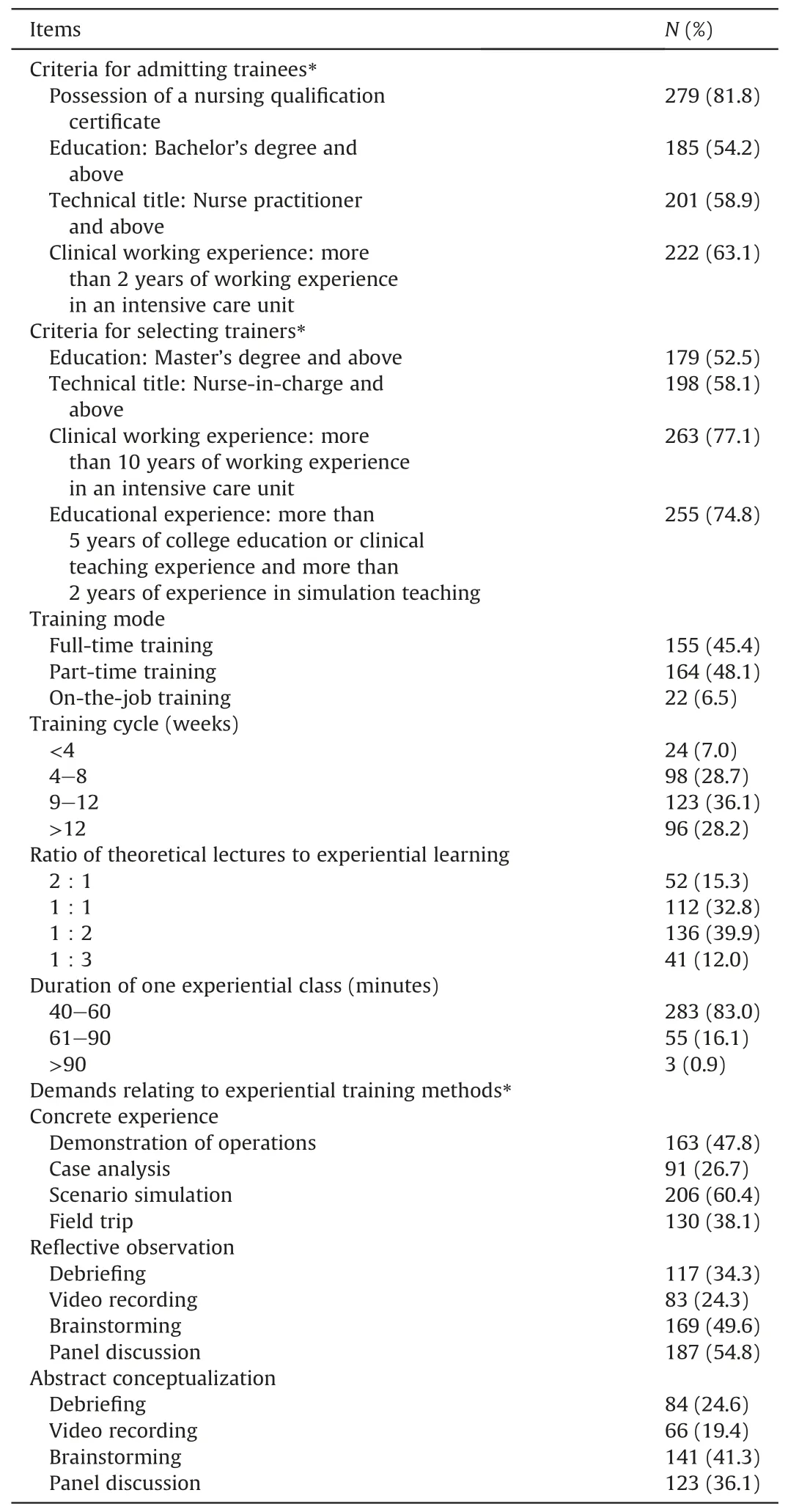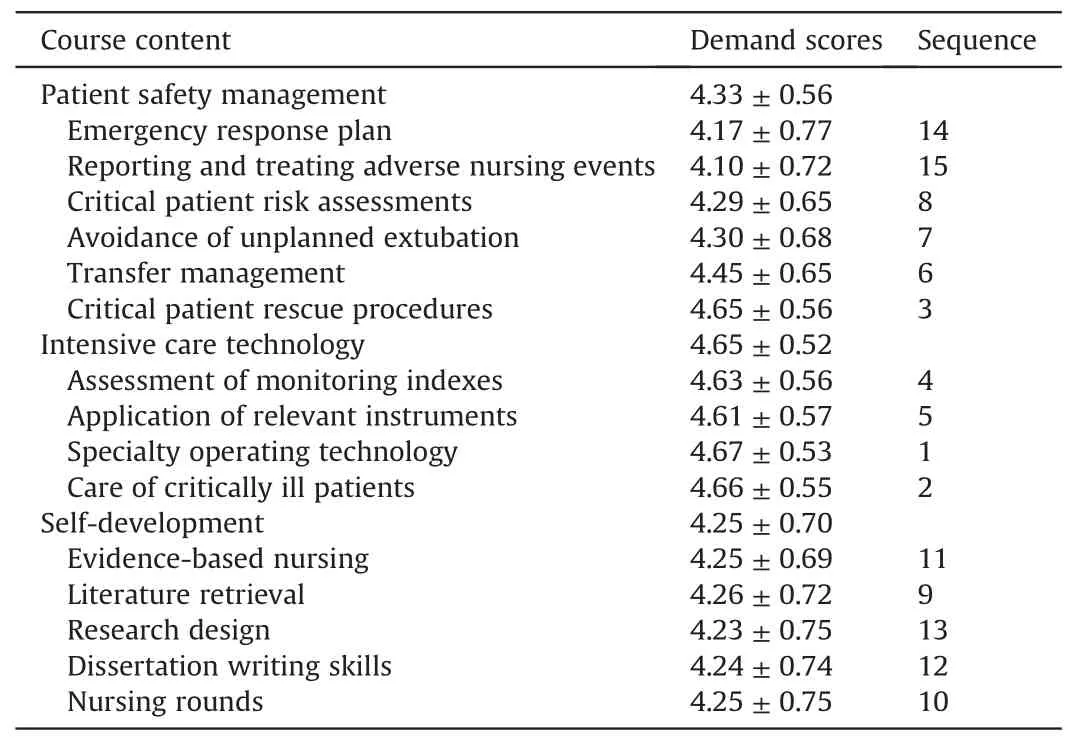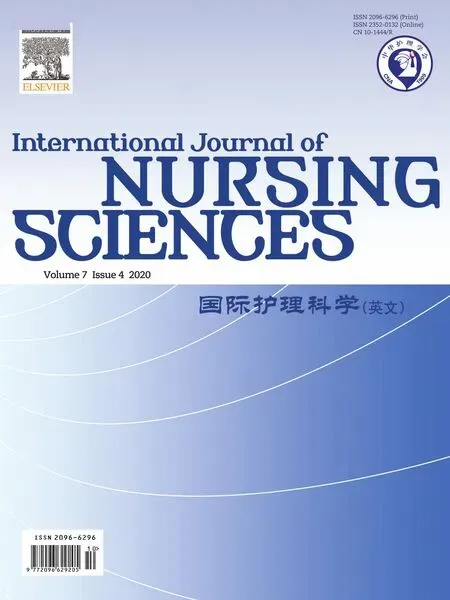Demands of experiential training for ICU nurses in Hunan of China
Yijia Xie ,Yangfan Xiao ,Jienan Zhou ,Lezhi Li
a Department of Vascular Surgery,the Second Xiangya Hospital of Central South University,Changsha,Hunan,China
b Department of Anesthesiology,the Second Xiangya Hospital of Central South University,Changsha,Hunan,China
c Clinical Nursing Teaching and Research Section,the Second Xiangya Hospital of Central South University,Changsha,Hunan,China
d Xiang Ya Nursing School,Central South University,Changsha,Hunan,China
Keywords:Intensive care units Nurses Experiential training Training demands
ABSTRACT Objective:To assess intensive care unit(ICU)nurses’demands for specialized experiential training and to provide inputs for developing an experiential training program for ICU nurses.Methods:A questionnaire for assessing ICU nurses’ demands for experiential specialty training was distributed to 360 ICU nurses,selected through purposive sampling from two secondary hospitals and six tertiary hospitals in Hunan Province,China.Results:Of the survey participants,63.6% had undergone a specialty training program for ICU nurses.Of these individuals,53.0%were satisfied with the training.Certification as a qualified nurse was considered an essential criterion for admission of trainees into the program by 81.8% of respondents,while 77.1% of respondents considered clinical working experience to be a critical requirement for selecting trainers.A total of 48.1%of the respondents preferred part-time training,and 36.1% considered a training cycle of 9-12 weeks to be reasonable.Moreover,they felt that the training methods should be tailored to different stages of the experiential learning cycle.Demands for experiential training among ICU nurses were quantified,with high demand reflected in an overall score of 4.41±0.48.The“intensive care technology”experiential training module was ranked highest in terms of demand,with the top five sub-modules being specialty operating technology (4.67 ± 0.53),care of critically ill patients (4.66 ± 0.55),critical patient rescue procedures(4.65± 0.56),assessing monitoring indexes (4.63± 0.56),and the application of relevant instruments (4.61 ± 0.57).Conclusion:Nearly half of the respondents indicated that their experiences of specialty training programs were not satisfactory,and they had high demands for experiential training.Thus,to optimize training outcomes,continuous updating of training methods is essential.Moreover,a systematic,comprehensive,and multilevel experiential training program that targets the specific needs of ICU nurses is essential.
What is known?
· The all-round abilities of ICU nurses directly affect the quality of the clinical care,which can be improved through specialty training programs that enhance their professional abilities.
· There are several deficiencies associated with conventional specialty training programs for ICU nurses.
· A combined approach entailing experiential learning and specialty training could effectively orient ICU nurses in their clinical practice.
What is new?
· The study revealed the specific areas of experiential training required by ICU nurses:intensive care technology,patient safety management,and self-development.
· There are evident differences in ICU nurses’demands relating to the course content of experiential training programs.
1.Introduction
Critical care medicine is a sub-discipline that entails multidisciplinary ambulance theories and monitoring technologies aimed at providing timely,standardized,and continuous monitoring and treatment of patients with life-threatening diseases [1].Critical care in relation to nursing is characterized by rapid knowledge advancement and the use of sophisticated equipment,complicated instruments,and multiple intensive care technologies under constantly changing conditions.Moreover,it is associated with high levels of psychological pressure.Accordingly,the occupational risks of ICU nurses are higher,and the occupational requirements are more rigorous compared with those associated with nurses who work in general wards.
The findings of previous studies indicate that ICU nurses can significantly improve the quality of care of patients while reducing their treatment costs and the lengths of their hospital stays [2,3].The all-round abilities of ICU nurses directly affect the quality of clinical care,and their professional abilities can be strengthened through the provision of specialty training.Moreover,strengthening ICU nurse specialty training is a priority within healthcarerelated policies.The China’s National Nursing Career Development Plan(2016-2020) highlights the importance of designing standardized specialty training and developing a body of nurses according to the requirements of the job [4].Accordingly,training programs for ICU nurses have been successively introduced in Chinese provinces.There are two primary types of training that are generally conducted over a period of three to six months:full-time and on-the-job training.The training programs,which are organized by health administrators or critical care associations,are mostly conducted in general teaching hospitals.Trainees receive a certification of qualification after passing the final assessment[5,6].
However,the specialty training available for ICU nurses in China remains underdeveloped and at a less advanced stage compared with such training programs in developed countries [7].There are five main constraints relating to the application of theoretical knowledge derived from traditional training programs in clinical practice focusing on critical care [8-10].The first constraint is limited training objectives.While the professional knowledge and skills required by ICU nurses in clinical work are emphasized,the cultivation of nurses’all-round abilities and dialectical thinking are neglected.Second,the training content is not inextricably linked to actual clinical work.Traditional training is perceived as being“useless” to some degree in bridging the gap between theoretical knowledge derived from the training program and actual practice in real clinical situations.Third,the training methods are simplified,and learning entails a passive process of merely receiving knowledge,resulting in a decrease or even a lack of interest and enthusiasm to learn on the part of the trainees.In light of these issues,nursing educators have been exploring the design of more advanced training methods to address problems of low efficiency levels and poor guidance provided through conventional training approaches as well as the trainees’ low motivation levels.
The tenet of underlying experiential learning is that the trainer develops a teaching scenario that simulates clinical nursing practice and orients trainees.Kolb’s model posits that experiential learning is split into four stages[11].Accordingly,training methods are tailored to the different characteristics of each of these four stages(Table 1).Compared with the conventional training method,one that entails a combination of experiential learning and specialty training is more effective in guiding clinical practice relating to ICU nursing,enabling trainees to learn and reflect on real experiences,communications,scenarios,feelings,and teamwork[12].The findings of existing studies suggest that experiential learning enables trainees to acquire knowledge and master technologies used in practice to enhance their skills in teamwork,humanistic health care,clinical coordination,critical thinking,and communication [13-15].A range of methods are commonly applied to cultivate experiential learning,such as demonstrated operations,case analysis,scenario simulation,video recording,and panel discussions.Such diversified forms of training stimulate the trainees’inherent learning motivation [16].
In recent years,simulation teaching has been widely recognized and practiced within medical education outside of China [17].Moreover,experiential learning has been extensively applied in diverse fields of nursing education internationally.A survey was conducted,focusing on a systematic experiential specialty training program and curricula derived from previous studies to assess Chinese ICU nurses’experiential training demands.The objective of the study was to create a foundation for developing a reasonable,standardized,and implementable experimental training program for ICU nurses.
2.Methods
2.1.Study design and sample
A cross-sectional design was adopted for this study using a webbased questionnaire.The questionnaire was distributed to registered ICU nurses with a range of specialties,who were selected through convenience sampling at two secondary hospitals and six tertiary hospitals in Hunan Province.The sample size was calculated as 10 times the number of the items in the questionnaire plus 20% of the invalid questionnaires.Thus,at least 300 participants were required for the study.Inclusion criteria applied in the study were registered clinical nurses who were currently providing intensive care in various ICU wards,who had provided informed consent,and who were voluntary participants.The exclusion criterion was registered nurses who had worked for less than two years.
The research was approved by the administrators of all of the surveyed hospitals.The questionnaire also included a clear statement confirming that the respondents had provided informed consent for their participation in the survey.Moreover,the welfare of the participants was guaranteed through the endorsement of the research protocol by the Intensive Care Professional Committee of the Hunan Nursing Association.The anonymity and confidentiality of the participants were also ensured in the web-based survey.
2.2.Instruments
A questionnaire titled “Questionnaire on the Demands of Intensive Care Unit(ICU)Nurses for Experiential Specialty Training”was used for the survey.It comprised three sections to elicit demographic and job-related characteristics,demands relating to an experiential specialty training program,and demands relating to experiential course content.A total of six experts (one ICU clinicalmedical specialist,three ICU clinical nurse specialists,one nursing education specialist,and one nursing management specialist)were recruited to review and revise the questionnaire.All of the experts held a bachelor’s degree or a higher qualification,had the title of associate professor or above,and had at least 10 years of experience in their respective professional fields.They repeatedly reviewed and revised the questionnaire.The content validity of the final version of the questionnaire (I-CVI) had a value of 0.833,and the Cronbach’s α for subscales of training demands ranged from 0.892 to 0.927.

Table 1 Four stages of experiential learning and corresponding training methods.
2.2.1.Demographic and job-related variables
Data were collected for the following background variables:sex,age,department,ICU working experience,hospital level,maximum educational level,technical title,and specialty training status.
2.2.2.Demands for an experiential specialty training program
The relevant literature relating to clinical applications of experiential training[18,19]was reviewed to identify relevant demands relating to the required qualifications of trainees and trainers,the training time and duration,and the training methods used during different stages of experiential learning.
2.2.3.Demands relating to experiential course content
We used the textbook titled Intensive Care Work Standard Operating Procedures as a reference for framing the study after consulting the relevant literature on training programs for ICU nurses worldwide [20-22].Fifteen items were identified and grouped into three modules.Respondents assigned a score to each item,ranging from 1 to 5:“strongly necessary”(5),“necessary”(4),“neutral”(3),“not necessary”(2),and“definitely not necessary”(1),with higher scores indicating higher demands.
2.3.Ethical considerations
Before the survey was administered,permission to conduct the study was obtained from the appropriate hospital administrators.This study was approved by the Ethics Committee of the Second Xiangya Hospital of Central South University (project number:2018/S047),after we had sought approval in writing for data collection.All participants in the online survey remained anonymous.
2.4.Data collection
Data were collected during the period July 1-31,2019.The head nurses of the ICUs at the different hospitals were first contacted,and they were informed of the aims of the study.Subjects were selected with the aid of the head nurses.The eligible candidates participated in the survey via WeChat or email.The questionnaire contained specific explanations on the purpose of the survey,relevant concepts,instructions on its completion,and contact information for subsequent consultations.Completed questionnaires in which over 10% of the questions were unanswered were eliminated.The data were compiled after being double checked,and a statistical analysis was performed.For the data analysis,statistical experts provided guidance to ensure that statistical methods were correctly applied.A total of 360 questionnaires were distributed,and 19 incomplete questionnaires were discarded.A total of 341 valid responses were returned,indicating a recovery rate of 94.72%.
2.5.Statistical analysis
All of the original data were inputted into Excel to construct a database.Subsequently,the data were screened to detect errors before the analysis was conducted using the SPSS version 23.0 software package.The normality of the distributions of all of the variables was determined prior to conducting the analysis.Means and rates were used to describe demographic characteristics.
3.Results
3.1.Demographic characteristics and the current status of specialty training for ICU nurses
A total of 63.6% of the survey participants had received ICU nurse specialty training.Of these participants,53% were satisfied with the training program.The top three areas requiring further improvement within training programs for ICU nurses were training methods (76.5%),training content (65.0%),and teaching staff (42.9%).Table 2 presents the respondents’ demographic characteristics and the current status of their specialty training as ICU nurses.

Table 2 Participants’ demographic profiles and current specialty training status as ICU nurses (n=341).

Table 3 Nurses’ demands regarding experiential teaching methods (n=341).
3.2.ICU nurses’ demands relating to experiential specialty training programs
Among the nurses who participated in the survey,81.8%felt that the key criterion for admitting trainees was their possession of a certificate listing their nursing qualification.Further,77.1% of the respondents felt that clinical working experience was the most important requirement for selecting trainers.The responses relating to the timing and duration of an experiential training program indicated that 48.1% of the respondents preferred parttime training and 36.1% considered a training cycle within a period of 9-12 weeks to be reasonable.Responses relating to demands for experiential training methods tailored to different stages revealed that 60.4%of the respondents selected scenario simulation during the stage of concrete experience,54.8% selected panel discussions during the stage of reflective observation,and 41.3%chose brainstorming during the stage of abstract conceptualization.Table 3 lists the respondents’ demands associated with an experiential specialty training program.
3.3.ICU nurses’ demands relating to experiential course content
The high demand for experiential specialty training among ICU nurses was reflected in an overall high score (4.41 ± 0.48).The demand scores for three experiential course modules were(4.65±0.52)for intensive care technology,(4.33±0.56)for patient safety management,and (4.25 ± 0.70) for self-development.The five top-ranked submodules were specialty operating technology,care of critical ill patients,procedures for resuscitating critical ill patients,assessing monitoring indexes,and the application of relevant instruments.The items exhibiting relatively lower scores were the reporting and treatment of adverse nursing events,emergency response plans,research design,dissertation writing skills,and evidence-based nursing.Table 4 presents demands relating to experiential course content.
4.Discussion
4.1.Insufficient specialty training for ICU nurses and less than desirable satisfaction levels with the training
The findings of a previous study indicated a decrease in the average age,academic credentials,and practical experience of Chinese ICU nurses[23].The findings of this study suggest that the average age of ICU nurses was(29.61±6.31)years.The mean period of practical experience in ICU nurses was (8.06 ± 5.49) years.A possible reason for the younger ages of ICU nurses is that experienced ICU nurses are more likely to experience burnout and to quit their ICU nursing positions.Several risk factors contribute to nurses’burnout and fatigue,such as heavy workloads,considerable occupational pressure,and the high frequency of on-call duties[24].Consequently,the loss of nurses with advanced practical experience results in a lack of sufficient working experience and poor comprehension within the ICU nurse cohort.The provision of specialty training programs for ICU nurses would considerably enhance their comprehensive abilities.However,36.4% of the surveyed ICU nurses had never received any special training.Of those who had,only 53.0%were satisfied with the training outcomes.The existing training status of ICU nurses suggests that a focus on theoretical lectures and repeated single-operation training that are relatively insignificant in providing practical guidance and the monotonous training method leads to a low degree of satisfaction and a lack of motivation to learn among trainees [25].
Although ICU nurse training has attracted increasing attention,this training is developing at a relatively slow pace.Given that the training of specialized nurses in China is still at a preliminary stage,the current training system remains far from the stage where it can meet the demands of ICU nurses [26].The findings of this study further revealed that there is considerable room for improving training methods,training content,and teaching staff.Training methods that more closely resemble clinical practice,homogeneous course content,and a reasonable training program are urgent priorities for enhancing the effectiveness of training programs and the quality of ICU nurses.Innovative training methods would also facilitate development of specialized training in other disciplines.

Table 4 Scores for demands relating to experiential course content.
4.2.Integration of experiential learning into training programs for ICU nurses and continuous updating of training methods
One of the most important differences between experiential and conventional teaching modes pertains to the treatment of the“trainee” as a training center [16].Trainers’ roles include the provision of guidance,assistance,and inspiration to motivate trainees and stimulate their inherent self-motivation to seek knowledge.While scenario simulation and other similar methods can be used to create experiential training scenarios for trainees,personal experience and reflection are required for the acquisition of knowledge,attitudes,and skills [27].Within existing studies,experiential teaching has been applied in various areas of teaching,such as emergency nursing,undergraduate nursing,newly licensed nurse training,care relating to chronic diseases,and humanistic care,with outstanding outcomes [19,28-31].Such training enhances the ability of team members to work collaboratively,while ensuring the orderly organization of intensive care and introducing a rational division of labor.The research subjects demonstrated strong demands for and a high degree of acceptance of experiential training.As revealed by the survey results,the research subjects preferred semi-off-line experiential training.Moreover,36.1%of the nurses preferred an 9-12 week training cycle,thus indicating that ICU nurses preferred to receive specialty training of short to medium duration,with assured financial resources.
4.3.Establishment of a demand-oriented ICU nurse training system
The survey results suggest that the overall demand of ICU nurses for experiential specialty training modules was high (4.41 ± 0.48).The top three ranked experiential specialty training modules were intensive care technology,patient safety management,and selfdevelopment.A possible reason for this ranking was that most of the survey respondents were junior nurses in the early stage of transforming their theoretical knowledge into clinical experience.Consequently,they paid more attention to experiential course content that related to the application of nursing knowledge and skills within clinical practice.Moreover,junior nurses emphasized practical abilities over safety and quality management or evidencebased research and teaching.However,senior nurses with higherlevel career orientations favored experiential courses relating to management.The results of a survey conducted among 1,440 specialist nurses in 36 tertiary hospitals in China also suggested that the demand for training on specialty operating technology was greatest among junior nurses (87.8%) and that training on nursing quality management was accorded the lowest priority(53.6%)[32].ICU nurses commonly demonstrated relatively low levels of proficiency in the areas of management,scientific research,teaching,and humanistic care [33].However,these areas constitute comprehensive skills that should be demonstrated by senior nurses in addition to being prerequisites to more specialized and refined nursing services.Further,nurses with these skills acquire a professional identity and their promotions are guaranteed.Higher level of medical service providers can cater to the diversified and multi-level health service needs of the public,and play an integral role in the development of a healthy Chinese population [34].
5.Limitations and prospects
This study inevitably had some limitations.First,the results and conclusions may not be generalizable to the national level,as most of the participants were from tertiary hospitals in Hunan Province.Subsequent studies should cover a wider sampling range and be expanded to incorporate primary hospitals as well as more secondary hospitals.Second,data were collected using a self-rated questionnaire because a standardized instrument is not available.However,the questionnaire was reviewed and approved by several qualified professional experts before it was distributed to respondents.The reliability of the questionnaire,which was assessed on the basis of the I-CVI and Cronbach’s α,was relatively high.Moreover,although we explored demands for specific experiential training modules,a complete experiential training program has not yet been developed.In light of the results of this survey,we will apply the Delphi method in a subsequent study to develop a multilevel experiential training program for ICU nurses.
6.Conclusion
Our findings revealed that a high proportion of ICU nurses are junior nurses.Whereas the nurses reported high demands for experiential training,these demands differed with regard to course content.Although experiential training has been progressively employed in various fields of nursing education,the training content remains broad.In a subsequent study,we will conduct practical research,entailing in-depth expert consultations to develop a multilevel experiential training program that targets ICU nurses and that is systematic,comprehensive,and demand-oriented.
Funding
This work was supported by the Natural Science Foundation of Hunan Province(No.2019JJ40431) and the Nursing Research Foundation of the Second Xiangya Hospital of Central South University(No.2017-YHL-21).
CRediT authorship contribution statement
Yijia Xie:Investigation,Writing -original draft.Yangfan Xiao:Investigation,Formal analysis,Data curation.Jienan Zhou:Investigation,Writing -review & editing.Lezhi Li:Conceptualization,Methodology,Supervision,Funding acquisition.
Declaration of competing interest
The authors have no conflicts of interest to declare.
Acknowledgments
This study could not have been completed without the cooperation of the registered nurses of the Second Xiangya Hospital of Central South University.
Appendix A.Supplementary data
Supplementary data to this article can be found online at https://doi.org/10.1016/j.ijnss.2020.09.010.
 International Journal of Nursing Sciences2020年4期
International Journal of Nursing Sciences2020年4期
- International Journal of Nursing Sciences的其它文章
- The risk factors of postpartum urinary retention after vaginal delivery:A systematic review
- Health personnel-targeted education interventions on inpatient suicide prevention in general hospitals:A scoping review
- Analysis of the evidence of related factors,associated conditions and at-risk populations of the NANDA-I nursing diagnosis insomnia
- Top 10 cited articles in Scopus:Midwife(2018—2020)
- Development and psychometric evaluation of Nurses and Midwives’Perceptions of their Roles in Primary Healthcare
- Top 10 cited articles in Scopus:Oncology nursing(2018—2020)
